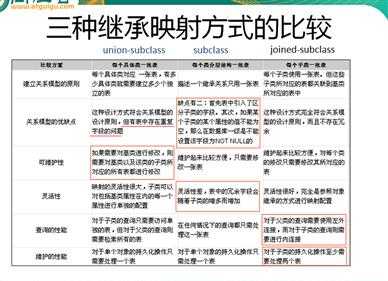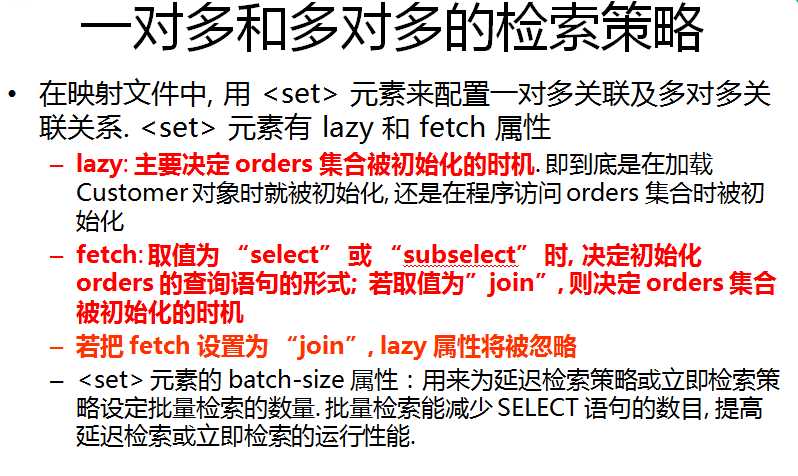标签:
继承映射:
1.subclass
1 <hibernate-mapping package="com.atguigu.hibernate.subclass"> 2 3 <class name="Person" table="PERSONS" discriminator-value="PERSON"> 4 5 <id name="id" type="java.lang.Integer"> 6 <column name="ID" /> 7 <generator class="native" /> 8 </id> 9 10 <!-- 配置辨别者列 --> 11 <discriminator column="TYPE" type="string"></discriminator> 12 13 <property name="name" type="java.lang.String"> 14 <column name="NAME" /> 15 </property> 16 17 <property name="age" type="int"> 18 <column name="AGE" /> 19 </property> 20 21 <!-- 映射子类 Student, 使用 subclass 进行映射 --> 22 <subclass name="Student" discriminator-value="STUDENT"> 23 <property name="school" type="string" column="SCHOOL"></property> 24 </subclass> 25 26 </class> 27 </hibernate-mapping>

1 /** 2 * 缺点: 3 * 1. 使用了辨别者列. 4 * 2. 子类独有的字段不能添加非空约束. 5 * 3. 若继承层次较深, 则数据表的字段也会较多. 6 */ 7 8 /** 9 * 查询: 10 * 1. 查询父类记录, 只需要查询一张数据表 11 * 2. 对于子类记录, 也只需要查询一张数据表 12 */ 13 @Test 14 public void testQuery(){ 15 List<Person> persons = session.createQuery("FROM Person").list(); 16 System.out.println(persons.size()); 17 18 List<Student> stus = session.createQuery("FROM Student").list(); 19 System.out.println(stus.size()); 20 } 21 22 /** 23 * 插入操作: 24 * 1. 对于子类对象只需把记录插入到一张数据表中. 25 * 2. 辨别者列有 Hibernate 自动维护. 26 */ 27 @Test 28 public void testSave(){ 29 30 Person person = new Person(); 31 person.setAge(11); 32 person.setName("AA"); 33 34 session.save(person); 35 36 Student stu = new Student(); 37 stu.setAge(22); 38 stu.setName("BB"); 39 stu.setSchool("ATGUIGU"); 40 41 session.save(stu); 42 43 }
2.joined-subclass:
1 <hibernate-mapping package="com.atguigu.hibernate.joined.subclass"> 2 3 <class name="Person" table="PERSONS"> 4 5 <id name="id" type="java.lang.Integer"> 6 <column name="ID" /> 7 <generator class="native" /> 8 </id> 9 10 <property name="name" type="java.lang.String"> 11 <column name="NAME" /> 12 </property> 13 14 <property name="age" type="int"> 15 <column name="AGE" /> 16 </property> 17 18 <joined-subclass name="Student" table="STUDENTS"> 19 <key column="STUDENT_id"></key> 20 <property name="school" type="string" column="SCHOOL"></property> 21 </joined-subclass> 22 23 </class> 24 </hibernate-mapping>

1 /** 2 * 优点: 3 * 1. 不需要使用了辨别者列. 4 * 2. 子类独有的字段能添加非空约束. 5 * 3. 没有冗余的字段. 6 */ 7 8 /** 9 * 查询: 10 * 1. 查询父类记录, 做一个左外连接查询 11 * 2. 对于子类记录, 做一个内连接查询. 12 */ 13 @Test 14 public void testQuery(){ 15 List<Person> persons = session.createQuery("FROM Person").list(); 16 System.out.println(persons.size()); 17 18 List<Student> stus = session.createQuery("FROM Student").list(); 19 System.out.println(stus.size()); 20 } 21 22 /** 23 * 插入操作: 24 * 1. 对于子类对象至少需要插入到两张数据表中. 25 */ 26 @Test 27 public void testSave(){ 28 29 Person person = new Person(); 30 person.setAge(11); 31 person.setName("AA"); 32 33 session.save(person); 34 35 Student stu = new Student(); 36 stu.setAge(22); 37 stu.setName("BB"); 38 stu.setSchool("ATGUIGU"); 39 40 session.save(stu); 41 42 }
3.union-subclass
1 <hibernate-mapping package="com.atguigu.hibernate.union.subclass"> 2 3 <class name="Person" table="PERSONS"> 4 5 <id name="id" type="java.lang.Integer"> 6 <column name="ID" /> 7 <generator class="hilo" /> 8 </id> 9 10 <property name="name" type="java.lang.String"> 11 <column name="NAME" /> 12 </property> 13 14 <property name="age" type="int"> 15 <column name="AGE" /> 16 </property> 17 18 <union-subclass name="Student" table="STUDENTS"> 19 <property name="school" column="SCHOOL" type="string"></property> 20 </union-subclass> 21 22 </class> 23 </hibernate-mapping>

1 /** 2 * 优点: 3 * 1. 无需使用辨别者列. 4 * 2. 子类独有的字段能添加非空约束. 5 * 6 * 缺点: 7 * 1. 存在冗余的字段 8 * 2. 若更新父表的字段, 则更新的效率较低 9 */ 10 11 /** 12 * 查询: 13 * 1. 查询父类记录, 需把父表和子表记录汇总到一起再做查询. 性能稍差. 14 * 2. 对于子类记录, 也只需要查询一张数据表 15 */ 16 @Test 17 public void testQuery(){ 18 List<Person> persons = session.createQuery("FROM Person").list(); 19 System.out.println(persons.size()); 20 21 List<Student> stus = session.createQuery("FROM Student").list(); 22 System.out.println(stus.size()); 23 } 24 25 /** 26 * 插入操作: 27 * 1. 对于子类对象只需把记录插入到一张数据表中. 28 */ 29 @Test 30 public void testSave(){ 31 32 Person person = new Person(); 33 person.setAge(11); 34 person.setName("AA"); 35 36 session.save(person); 37 38 Student stu = new Student(); 39 stu.setAge(22); 40 stu.setName("BB"); 41 stu.setSchool("ATGUIGU"); 42 43 session.save(stu); 44 45 }

二:检索策略:

1 @Test 2 public void testMany2OneStrategy(){ 3 // Order order = (Order) session.get(Order.class, 1); 4 // System.out.println(order.getCustomer().getCustomerName()); 5 6 List<Order> orders = session.createQuery("FROM Order o").list(); 7 for(Order order: orders){ 8 if(order.getCustomer() != null){ 9 System.out.println(order.getCustomer().getCustomerName()); 10 } 11 } 12 13 //1. lazy 取值为 proxy 和 false 分别代表对应对应的属性采用延迟检索和立即检索 14 //2. fetch 取值为 join, 表示使用迫切左外连接的方式初始化 n 关联的 1 的一端的属性 15 //忽略 lazy 属性. 16 //3. batch-size, 该属性需要设置在 1 那一端的 class 元素中: 17 //<class name="Customer" table="CUSTOMERS" lazy="true" batch-size="5"> 18 //作用: 一次初始化 1 的这一段代理对象的个数. 19 } 20 21 @Test 22 public void testSetFetch2(){ 23 Customer customer = (Customer) session.get(Customer.class, 1); 24 System.out.println(customer.getOrders().size()); 25 } 26 27 @Test 28 public void testSetFetch(){ 29 List<Customer> customers = session.createQuery("FROM Customer").list(); 30 31 System.out.println(customers.size()); 32 33 for(Customer customer: customers){ 34 if(customer.getOrders() != null) 35 System.out.println(customer.getOrders().size()); 36 } 37 38 //set 集合的 fetch 属性: 确定初始化 orders 集合的方式. 39 //1. 默认值为 select. 通过正常的方式来初始化 set 元素 40 //2. 可以取值为 subselect. 通过子查询的方式来初始化所有的 set 集合. 子查询 41 //作为 where 子句的 in 的条件出现, 子查询查询所有 1 的一端的 ID. 此时 lazy 有效. 42 //但 batch-size 失效. 43 //3. 若取值为 join. 则 44 //3.1 在加载 1 的一端的对象时, 使用迫切左外连接(使用左外链接进行查询, 且把集合属性进行初始化)的方式检索 n 的一端的集合属性 45 //3.2 忽略 lazy 属性. 46 //3.3 HQL 查询忽略 fetch=join 的取值 47 } 48 49 @Test 50 public void testSetBatchSize(){ 51 List<Customer> customers = session.createQuery("FROM Customer").list(); 52 53 System.out.println(customers.size()); 54 55 for(Customer customer: customers){ 56 if(customer.getOrders() != null) 57 System.out.println(customer.getOrders().size()); 58 } 59 60 //set 元素的 batch-size 属性: 设定一次初始化 set 集合的数量. 61 } 62 63 @Test 64 public void testOne2ManyLevelStrategy(){ 65 Customer customer = (Customer) session.get(Customer.class, 1); 66 System.out.println(customer.getCustomerName()); 67 68 System.out.println(customer.getOrders().size()); 69 Order order = new Order(); 70 order.setOrderId(1); 71 System.out.println(customer.getOrders().contains(order)); 72 73 Hibernate.initialize(customer.getOrders()); 74 75 //---------------set 的 lazy 属性------------------ 76 //1. 1-n 或 n-n 的集合属性默认使用懒加载检索策略. 77 //2. 可以通过设置 set 的 lazy 属性来修改默认的检索策略. 默认为 true 78 //并不建议设置为 false. 79 //3. lazy 还可以设置为 extra. 增强的延迟检索. 该取值会尽可能的延迟集合初始化的时机! 80 } 81 82 @Test 83 public void testClassLevelStrategy(){ 84 Customer customer = (Customer) session.load(Customer.class, 1); 85 System.out.println(customer.getClass()); 86 87 System.out.println(customer.getCustomerId()); 88 System.out.println(customer.getCustomerName()); 89 }
标签:
原文地址:http://www.cnblogs.com/liuqing-bk/p/4812221.html